 W
WAlmond Blossoms is a group of several paintings made in 1888 and 1890 by Vincent van Gogh in Arles and Saint-Rémy, southern France of blossoming almond trees. Flowering trees were special to van Gogh. They represented awakening and hope. He enjoyed them aesthetically and found joy in painting flowering trees. The works reflect the influence of Impressionism, Divisionism, and Japanese woodcuts. Almond Blossom was made to celebrate the birth of his nephew and namesake, son of his brother Theo and sister-in-law Jo.
 W
WLes Alyscamps is a pair of paintings ("pendants") by Dutch painter Vincent van Gogh. Painted in 1888 in Arles, France, it depicts autumnal scenes in the Alyscamps, an ancient Roman necropolis in Arles which is lined with poplars and stone sarcophagi.
 W
WLes Arènes is a painting by Vincent van Gogh executed in Arles, in November or December 1888, during the period of time when Paul Gauguin was living with him in The Yellow House. The bullfight season in Arles that year started on Easter Sunday 1 April and ended on 21 October. Van Gogh's painting is therefore not a study from nature but done from memory. Gauguin encouraged van Gogh to work in the studio in this manner. The painting may not be finished as the paint is very thinly applied, and patches of bare jute show through in places.
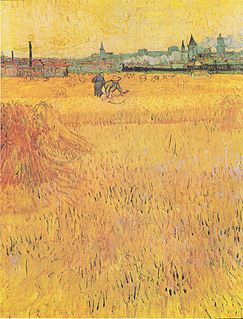 W
WArles: View from the Wheat Fields was painted by Vincent van Gogh in June, 1888, among a number of paintings he made of wheat fields that summer. It is currently displayed at the Musee Rodin in Paris, France.
 W
WL'Arlésienne, L'Arlésienne : Madame Ginoux, or Portrait of Madame Ginoux is the title given to a group of six similar paintings by Vincent van Gogh, painted in Arles, November 1888, and in Saint-Rémy, February 1890. L'Arlésienne means literally "the woman from Arles".
 W
WBedroom in Arles is the title given to each of three similar paintings by 19th-century Dutch Post-Impressionist painter Vincent van Gogh.
 W
WBoats du Rhône is a series of two sketches and three oil paintings, listed below, created by the Dutch artist Vincent van Gogh while living in Arles, France, during August, 1888.
 W
WButterflies is a series paintings made by Vincent van Gogh in 1889 and 1890. Van Gogh made at least four paintings of butterflies and one of a moth. The metamorphosis of the caterpillar into a butterfly was symbolic to Van Gogh of men and women's capability for transformation.
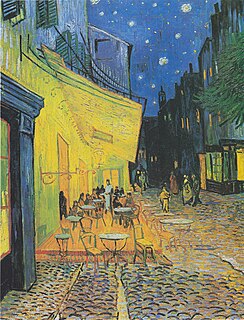 W
WCafé Terrace at Night is an 1888 oil painting by the Dutch artist Vincent van Gogh. It is also known as The Cafe Terrace on the Place du Forum, and, when first exhibited in 1891, was entitled Coffeehouse, in the evening.
 W
WDécoration for the Yellow House was the main project Vincent van Gogh focused on in Arles, from August 1888 until his breakdown the day before Christmas. This Décoration had no pre-defined form or size; the central idea of the Décoration grew step by step, with the progress of his work. Starting with the Sunflowers, portraits were included in the next step. Finally, mid-September 1888, the idea took shape: from this time on he concentrated on size 30 canvases, which were all meant to form part of this Décoration.
 W
WFall of Leaves , or Falling Autumn Leaves is a pair of paintings by the Dutch painter Vincent van Gogh. They were executed during the two months at the end of 1888 that his artist friend Paul Gauguin spent with him at The Yellow House in Arles, France.
 W
WFarmhouse in Provence, also known as Entrance Gate to a Farm with Haystacks, is an oil-on-canvas painting produced in 1888 by Dutch painter Vincent van Gogh in Arles, Provence, at the height of his career. Partially due to having been inspired by painter Adolphe Monticelli, Van Gogh sought the Provence region of France to further expand his painting skill and experience. Van Gogh used several pairs of complementary colors in the Farmhouse in Provence, the color contrast bringing an intensity to his work. The painting is owned by the National Gallery of Art in Washington, D.C.
 W
WFlowering Orchards is a series of paintings which Dutch artist Vincent van Gogh executed in Arles, in southern France in the spring of 1888. Van Gogh arrived in Arles in February 1888 in a snowstorm; within two weeks the weather changed and the fruit trees were in blossom. Appreciating the symbolism of rebirth, Van Gogh worked with optimism and zeal on about fourteen paintings of flowering trees in the early spring. He also made paintings of flowering trees in Saint-Rémy the following year, in 1889.
 W
WGreen Wheat Field with Cypress is an oil-on-canvas painting by Dutch Post-Impressionist Vincent van Gogh. It is held by the National Gallery Prague, displayed at the Veletržní palác in the district of Holešovice, where the painting is known as Zelené obilí.
 W
WHospital at Arles is the subject of two paintings that Vincent van Gogh made of the hospital in which he stayed in December 1888 and again in January 1889. The hospital is located in Arles in southern France. One of the paintings is of the central garden between four buildings titled Garden of the Hospital in Arles ; the other painting is of a ward within the hospital titled Ward of the Hospital in Arles. Van Gogh also painted Portrait of Dr. Félix Rey, a portrait of his physician while in the hospital.
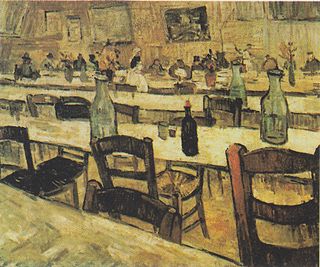 W
WInterior of a Restaurant in Arles is a colored oil painting by Dutch artist Vincent van Gogh on an industrially primed canvas of size 25 (Toile de 25 figure) in Arles, France, late August, 1888.
 W
WA Lane in a Public Garden in Arles is an 1888 painting by Vincent van Gogh depicting a lane running through the public garden in Arles.
 W
WThe Langlois Bridge at Arles is the subject of four oil paintings, one watercolor and four drawings by Vincent van Gogh. The works, made in 1888 when Van Gogh lived in Arles, in southern France, represent a melding of formal and creative aspects. Van Gogh used a perspective frame that he built and used in The Hague to create precise lines and angles when portraying perspective.
 W
WList of drawings by Vincent van Gogh is an incomplete collection of drawings by the Dutch artist Vincent van Gogh (1853–1890) that form an important part of his complete body of work. The listing is ordered by year and then by catalogue number. While more accurate dating of Van Gogh's work is often difficult. As a general rule the numbering from Jan Hulsker's catalogue is more precise chronologically
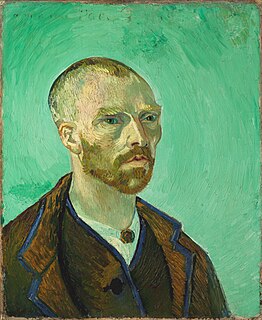 W
WList of works by Vincent van Gogh is an incomplete list of paintings and other works by the Dutch artist Vincent van Gogh (1853–1890). Little appreciated during his lifetime, his fame grew in the years after his death. According to the legend, Van Gogh sold only one painting, The Red Vineyard, bought for 400 francs by the painter and art collector Anna Boch. Today, he is widely regarded as one of history's greatest painters and an important contributor to the foundations of modern art. Van Gogh did not begin painting until his late twenties, and most of his best-known works were produced during his final two years. He produced more than 2,000 artworks, consisting of around 900 paintings and 1,100 drawings and sketches. In 2013, Sunset at Montmajour became the first full-sized Van Gogh painting to be newly confirmed since 1928.
 W
WLa Mousmé also known as La Mousmé, Sitting in a Cane Chair, Half-Figure was painted by Vincent van Gogh in 1888 while living in Arles, which van Gogh dubbed "the Japan of the south". Retreating from the city, he hoped that his time in Arles would evoke in his work the simple, yet dramatic expression of Japanese art.
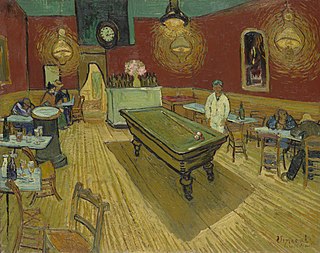 W
WThe Night Café is an oil painting created by Dutch artist Vincent van Gogh in September 1888 in Arles. Its title is inscribed lower right beneath the signature. The painting is owned by Yale University and is currently held at the Yale University Art Gallery in New Haven, Connecticut.
 W
WVincent van Gogh enjoyed making Paintings of Children. He once said that it's the only thing that "excites me to the depths of my soul, and which makes me feel the infinite more than anything else." Painting children, in particular represented rebirth and the infinite. Over his career Van Gogh did not make many paintings of children, but those he completed were special to him. During the ten years of Van Gogh's career as a painter, from 1881 to 1890, his work changed and grew richer, particularly in how he used color and techniques symbolically or evocatively.
 W
WThe Roulin Family is a group of portrait paintings Vincent van Gogh executed in Arles in 1888 and 1889 on Joseph, his wife Augustine and their three children: Armand, Camille and Marcelle. This series is unique in many ways. Although Van Gogh loved to paint portraits, it was difficult for financial and other reasons for him to find models. So, finding an entire family that agreed to sit for paintings — in fact, for several sittings each — was a bounty.
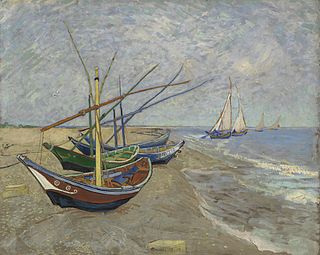 W
WSaintes-Maries is the subject of a series of paintings that Vincent van Gogh made in 1888. When Van Gogh lived in Arles, he took a trip to Saintes-Maries-de-la-Mer on the Mediterranean Sea, where he made several paintings of the seascape and town.
 W
WStarry Night, commonly known as Starry Night Over the Rhône, is one of Vincent van Gogh's paintings of Arles at night. It was painted on the bank of the Rhône that was only a one or two-minute walk from the Yellow House on the Place Lamartine, which Van Gogh was renting at the time. The night sky and the effects of light at night provided the subject for some of van Gogh's more famous paintings, including Café Terrace at Night and the June, 1889, canvas from Saint-Remy, The Starry Night.
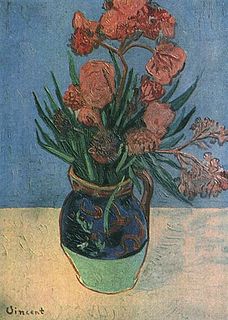 W
WVase with Oleanders was made in 1888 by Vincent van Gogh. The work's location is unknown and it is possibly stolen or possibly destroyed.
 W
WSunflowers is the title of two series of still life paintings by the Dutch painter Vincent van Gogh. The first series, executed in Paris in 1887, depicts the flowers lying on the ground, while the second set, made a year later in Arles, shows a bouquet of sunflowers in a vase. In the artist's mind both sets were linked by the name of his friend Paul Gauguin, who acquired two of the Paris versions. About eight months later van Gogh hoped to welcome and to impress Gauguin again with Sunflowers, now part of the painted Décoration for the Yellow House that he prepared for the guestroom of his home in Arles, where Gauguin was supposed to stay. After Gauguin's departure, van Gogh imagined the two major versions as wings of the Berceuse Triptych, and finally he included them in his Les XX in Bruxelles exhibit.
 W
WSunset at Montmajour is a landscape in oils painted by the Dutch artist Vincent van Gogh on 4 July 1888. It was painted while the artist was at Arles, France and depicts a landscape of garrigue with the ruins of Montmajour Abbey in the background. The painting is 73.3 cm × 93.3 cm and was on display from 24 September 2013 until 12 January 2014 as part of an exhibition at the Van Gogh Museum in Amsterdam.
 W
WTrees and Undergrowth is the subject of paintings that Vincent van Gogh made in Paris, Saint-Rémy and Auvers, from 1887 through 1890. Van Gogh made several paintings of undergrowth, a genre called "sous-bois" brought into prominence by artists of the Barbizon School and Impressionists. The works from this series successfully use shades of color and light in the forest or garden interior paintings. Van Gogh selected one of his Saint-Rémy paintings, Ivy (F609) for the Brussels Les XX exhibition in 1890.
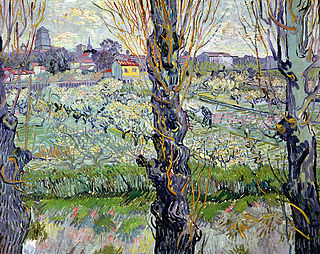 W
WView of Arles, Flowering Orchards is a painting by Vincent van Gogh, executed in spring 1889, one of several paintings he produced in his Flowering Orchards series while living in Arles.
 W
WThe Red Vineyards near Arles is an oil painting by the Dutch painter Vincent van Gogh, executed on a privately primed Toile de 30 piece of burlap in early November 1888. It depicts workers in a vineyard, and is believed to be the only painting known by name that van Gogh sold during his lifetime.
 W
WWheat Fields is a series of dozens of paintings by Dutch Post-Impressionist artist Vincent van Gogh, borne out of his religious studies and sermons, connection to nature, appreciation of manual laborers and desire to provide a means of offering comfort to others. The wheat field works demonstrate his progression as an artist from the drab Wheat Sheaves made in 1885 in the Netherlands to the colorful and dramatic 1888–1890 paintings from Arles, Saint-Rémy and Auvers-sur-Oise in rural France.
 W
WThe Yellow House, alternatively named The Street, is an 1888 oil painting by the 19th-century Dutch Post-Impressionist painter Vincent van Gogh.
 W
WThe Zouave is the subject of several sketches and paintings made by Vincent van Gogh in Arles.